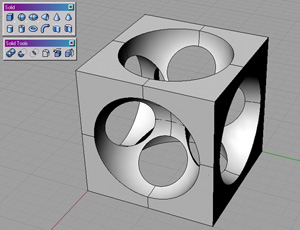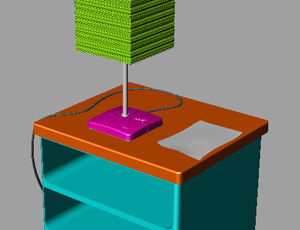|
+Rhino
Training Courses
+Rhino Level 1
one week
Course Duration: 40 hours
Tuition: $1800 US
Overview: During this Rhino level 1 training
course students will learn about surface modeling and discuss general
modeling approaches relating specifically to Rhino 3D Software. In this
class you'll learn to create and edit accurate and free-form 3-D NURBS
curves and surfaces. This fast-moving class covers most of Rhino's functionality,
including the most advanced surfacing commands. In this comprehensive
five day class you'll learn to create and modify accurate and free-form
3-D NURBS models. The last day of this class also includes one day of
Flamingo, Vray or Maxwell rendering instruction.
Prerequisite: Industrial Design degree
or CAD experience helpful but not necessary.
 |
| Part
of the basic blocks to aid in learning Rhino |
 |
| building
interior items in Rhino |
Topics:
- Creating surfaces from curves
- Interface Exploration
- View port Layout
- Layer Management
- Modify Curves and Surfaces with Edit Commands
- 3d Models from 2drawings and scanned images
- Boolean Primitive Geometry
- Extrusions
- Object Snaps
- Lines in 3d Space
- Revolves
- Arrays
- Curve on Surface
- Focus on rounds and blends.
- Text on surface
- Extract Edge
- Loft, Patch, Sweep2rails,
- Zebra and Environment Analysis
- Surfacing Tools - sweeps, revolves, lofting and surface from curve
network
- Curves from objects
- Managing the implied tangency (across mirror plane)
Discussions:
- Identify the different ways to display geometry
- Trim vs. Split vs. Project/Split/Delete
- Curve on Surface vs. Projected Curve
- Plan your model from concept sketch to final construction
- Strengths and weaknesses of boolean solids
- Surface curve networks and alternate uses for this tool
- Discuss the difference between lofts and sweeps
- Discuss Surface and Curve analysis tools Zebra, draft angle,
- Discuss rules common to all surface models
- Rendering in Flamingo vs other popular rendering packages
- Detail and realism
- Discuss typical and atypical workflow for industrial designers.
- Discuss basics of rendering
- Discuss A-Class surfacing
|